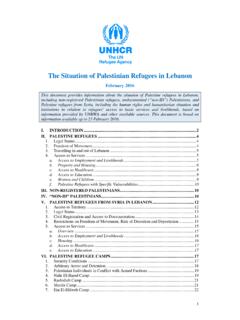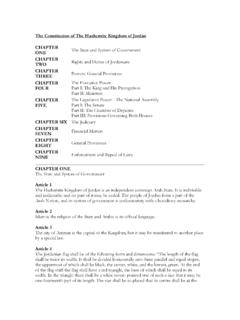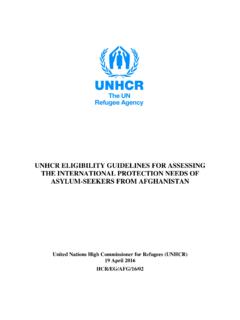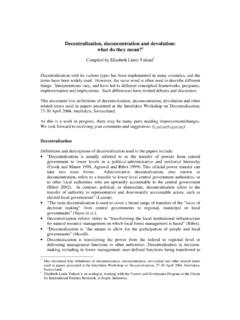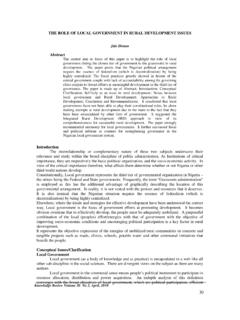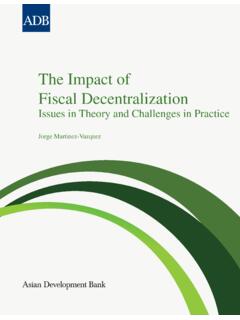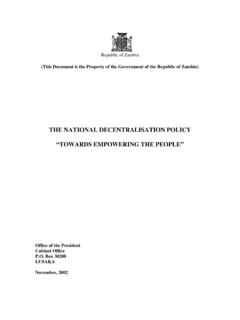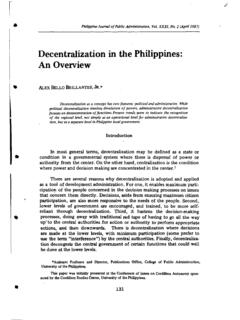Transcription of ETHIOPIA: A SITUATION ANALYSIS AND TREND ASSESSMENT
1 WRITENET independent ANALYSIS writenet is a network of researchers and writers on human rights, forced migration, ethnic and political conflict writenet is the resource base of practical management (uk) e-mail: ETHIOPIA: A SITUATION ANALYSIS AND TREND ASSESSMENT A Writenet Report by Sarah Vaughan commissioned by United Nations High Commissioner for Refugees, Protection Information Section (DIP) January 2004 Caveat: Writenet papers are prepared mainly on the basis of publicly available information, ANALYSIS and comment. The papers are not, and do not purport to be, either exhaustive with regard to conditions in the country surveyed, or conclusive as to the merits of any particular claim to refugee status or asylum.
2 The views expressed in the paper are those of the author and are not necessarily those of UNHCR, Writenet or Practical Management. ETHIOPIA: A SITUATION ANALYSIS AND TREND ASSESSMENT TABLE OF CONTENTS List of Executive 1 2 Review of the Contemporary Ethnic Federalism: Constitutional Framework and Organization of the Political Representation: Parliamentary Recourse to Justice: the Judiciary and Recourse to Force: the Military and Security Conclusions and The Political Party The Ruling Party, 15 EPRDF-affiliated Organizations in So-called Emergent Opposition Multi-partyism and the Electoral Conclusions and Civil Society / Associational Religious 20 Developmental Activity: NGOs and Civic The Private Commercial Activity.
3 The Private Conclusions and Popular Relevant Trends in Socio-political Local Experiences of State Authority 26 3 Contemporary Threats to Sociopolitical and Human Conflict and So-called Ethnic So-called Pastoralist Conflict for Control of the The Aftermath of the Ethio-Eritrean War, Economic Threats: Food Insecurity, Poverty, Major Strands of Economic Issues of Concern in Economic The State and Political The Impact of Ethnic The Treatment of Political Activists and Social Sanctioning of Human Rights Women s Rights and Gendered Taboos and Occupational Treatment of the Landless, Destitute and Factors Influencing Trends and The State and Political Socio-economic 4 Refugee and IDP Movements and The Current Somali Sudanese Kenyan and Djiboutian IDPs/refugees from Eritrean Border Other 45 Ethiopian Factors Influencing Trends and The Domestic (In)stability in Neighbouring Relations and Conflict with Neighbouring 5 Conclusions.
4 Trends and Policy The Current SITUATION , and Policy 6 ii List of Acronyms AAPO All-Amhara People s Organization AAU Addis Ababa University ACC Anti-Corruption Commission ADLI Agricultural Development-Led Industrialization AEUP All-Ethiopia Unity Party (formerly AAPO) ANDM Amhara National Democratic Movement (EPRDF member) ARRA Administration for Refugee and Returnee Affairs CBE Commercial Bank of Ethiopia CSA Central Statistical Agency DMLEK Democratic Movement for the Liberation of Eritrean Kunama EDP Ethiopian Democratic Party EDU Ethiopian Democratic Union EDUP Ethiopian Democratic Unity Party (EDU and EDP merger) EEBC Eritrea-Ethiopia Boundary Commission EFFORT Endowment Fund for the Rehabilitation of Tigray EHRCO Ethiopian Human Rights Council EIU Economist Intelligence Unit EPDM Ethiopian People s Democratic Movement (now ANDM) EPLF Eritrean People s Liberation Front EPRDF Ethiopian People s Revolutionary Democratic Front EPRP Ethiopian People s Revolutionary Party EWLA Ethiopian Women Lawyers Association FCO (UK) Foreign and Commonwealth Office FDRE Federal Democratic Republic of Ethiopia FGM Female Genital Mutilation (GO)NGO (government-oriented)
5 Non-governmental organization GPDM Gambella People s Democratic Movement GPDUP Gambella People s Democratic Unity Party ICRC International Committee of the Red Cross IDP Internally Displaced Person IGAD Inter-Governmental Agency on Development IMF International Monetary Fund NOVIB Netherlands Organization for International Development Co-operation OAU Organization of African Unity OLF Oromo Liberation Front ONC Oromo National Congress ONLF Ogaden National Liberation Front OPDO Oromo People s Democratic Organization (ERPDF member) PDO People s Democratic Organization iii PSCAP Public Service Delivery Capacity Building Programme REST Relief Society of Tigray SEPDC Southern Ethiopian Peoples Democratic Coalition SEPDF Southern Ethiopian People s Democratic Front (EPRDF member) SIRAA Security, Immigration and Refugee Affairs Agency SNNPRS Southern Nations, Nationalities and Peoples Regional State SPLA Sudan People s Liberation Army SPO Special Prosecutor s Office SSIM South Sudan Independence Movement TGE Transitional Government of Ethiopia TPLF Tigray People s Liberation Front (EPRDF member)
6 UEDF United Ethiopian Democratic Forces UNAIDS Joint United Nations Programme on HIV/AIDS UNHCR United Nations High Commissioner for Refugees UNMEE UN Mission in Ethiopia and Eritrea USAID United States Agency for International Development USCR United States Committee for Refugees WPE Workers Party of Ethiopia (Dergue era) iv Executive Summary Since 1991 the Ethiopian government has been engaged in three major processes of reform, designed to reduce levels of conflict which had torn the region apart for several decades: decentralization of the state, by the establishment of a federation based on the major language groups; democratization of its politics, by means of multiparty competitive elections for office; liberalization of its former command economy.
7 Significant progress has been made in each of these areas, and significant constraints remain. Self-determination formally places political autonomy in the hands of Ethiopia s multiple ethnic groups, and has given places in government to elites from many groups who had never before experienced it. In practice, it is difficult to establish whether federal decentralization extends to devolution of power, or is limited to deconcentration of responsibility, since, in much of the country, the ruling party administers all levels of government. The dominance of the EPRDF also raises questions about the nature of Ethiopia s multiparty democracy, with opposition organizations remaining external or peripheral to the exercise of power, as well as weak and divided.
8 Elections in 2004 can be expected to be harder fought than ever, and their conduct scrutinized closely. Whilst the capacity of the state, and the professionalization of its administrators, have been constructed over the last decade, the success of programmes for reform of the police, military, security and judiciary remain critical to future developments. Whilst civil society bodies have grown exponentially since 1991, their capacity to lobby and influence the state has been limited. By far the most important factor threatening the rights of Ethiopians and refugees living in Ethiopia is the insecurity that results from poverty, and from continuing low-level conflict. Whilst the government is committed to a range of policies designed to boost agricultural production, education and the provision of socio-economic services, poverty and food insecurity continue to increase, exacerbated by population growth, environmental and climatic factors, inadequacies of domestic marketing, and disastrous terms of international trade.
9 High rates of HIV/AIDS infection are beginning to emerge as a further negative socio-economic factor. Whilst much reduced from the period of the civil war leading up to 1991, low-level conflict continues throughout the pastoralist periphery of the country, and regularly flares in multi-ethnic areas. Neither category of conflict can be adequately understood in terms of pastoralism or ethnicity, and instances of conflict display a myriad of economic, social, cultural, historical and political roots and causes, which require individual documentation and ANALYSIS . Conflict is frequently exacerbated by competition for control of the state, which often takes a conflictual form, with a number of groups continuing to conduct an armed opposition to the government.
10 Other factors which influence the SITUATION of refugees and Ethiopian citizens include socio-cultural attitudes which marginalize women and occupational and other minority groups. The SITUATION in several of Ethiopia s neighbouring countries, and in its own peripheries, can be expected to remain sufficiently volatile to render patterns of refugee movements unpredictable. Relations with Eritrea are not expected to improve in the immediate future. v ETHIOPIA: A SITUATION ANALYSIS AND TREND ASSESSMENT 1 Introduction1 Twelve years ago the incoming Transitional Government of Ethiopia (TGE), led by the Ethiopian People s Revolutionary Democratic Front (EPRDF), inherited a centralized, authoritarian state and the ruins of a command economy.





